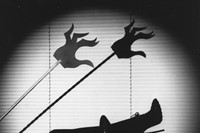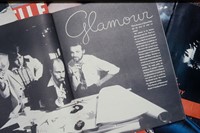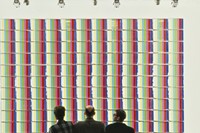Reality and fiction seem to have always danced together in beloved and influential works in recent decades, but perhaps never with as much conviction or social commentary as in the work of Canadian collective General Idea. Now the group, founded by
Reality and fiction seem to have always danced together in beloved and influential works in recent decades, but perhaps never with as much conviction or social commentary as in the work of Canadian collective General Idea. Now the group, founded by Jorge Zontal, Felix Partz and AA Bronson, which began producing joint works in 1969, are featured in the retrospective Haute Culture: General Idea at the Musee d'Art moderne de la Ville de Paris, their first in Europe. Over three hundred works, produced between 1969 and 1994 – paintings, installations, sculptures, photographs, videos, magazines and a TV programme – are shown together, illustrating how progressive the concepts the trio worked were, such as the creation of FILE magazine, which they founded in 1972 and that allowed readers and artists to submit work. Like many of the trio's works, it has become a kind of model for today. AnOther spoke with the group's surviving member, AA Bronson, who is currently working on a series of stone sculptures and collaboration in the form of a book, Queer Spirits, which will soon be released, about the exhibition. And so, thankfully, the dance continues.
What is the spirit or mood of the retrospective?
The retrospective itself manages to be spunky and mischievous and of the moment, even though the work dates back decades now. It's interesting how much work by younger artists is anticipated here. However, for me, the exhibition is more like a massive meandering memorial. Each of more than 300 works has its story to tell, and brings with it memories of the 25-years that Jorge, Felix, and I spent together. So for me it is sad.
When we spoke last, you mentioned that you, in a way, incorporate the idea of aging into your work. Is this something you're still thinking about? How will your art progress in the near future? I know you were working on two large sculptures recently.
Yes, this is something I am still thinking about, although I can't say I have progressed much since the last time we talked! I am currently working on a series of large stone sculptures, which I hope to exhibit at Esther Schipper, Berlin, this coming fall. And my new book, Queer Spirits, collaboration with Peter Hobbs, will be released in a few weeks.
You've said that a single moment in one's life can change everything, from our lives to the way we think. What do you feel is the last moment like this that you experienced?
We each have that moment where our interior Berlin wall falls. It can happen without warning and transform our lives, both outer and inner. For me, it was three hours after my partner Felix died. He died of AIDS at home. I clicked the shutter on my camera and took the photo that later became a large-scale artwork: Felix, June 5, 1994. The hair on the nape of my neck stood up, and I knew my life would never be the same.
Can you please tell us about a time, project or opening that you think really defined exactly what you, Jorge and Felix had dreamed of accomplishing?
What did we dream of accomplishing? I am not sure I know the answer to that. We wanted to be provocateurs, to question the status quo, to be the court jesters to today's society of consumerist imperialism, to be the ones who spoke the truth at a time when the truth was socially unacceptable. Perhaps this exhibition at the Musée d'art moderne de la Ville de Paris gets as close to that moment as anything.
How does the retrospective convey the works' messages and sensibilities effectively?
The curator, Frédéric Bonnet, has organized the work by theme, mixing together works from various decades in an almost giddy panoply of visual themes and concepts. A Dutch museum director complained of being "over-poodled" on emerging from the show, and, although he said it in jest, his remark captures the immersive quality of the show. It's a little bit like going through a car wash and having your sensibilities polished with General Idea's witty variety of camp critique and visual aphorism.
How have you been involved in it?
To tell the truth, I have been trying to give the curator room to carry out his own very interesting vision of what General Idea was and what it can be for us today. Each day I came and answered a long list of questions, and then went away again. I think the results are refreshing: the exhibition incorporates my depth of knowledge while breathing new life into the works. I am very interested to see what the public reaction will be.
Haute Culture: General Idea, Une rétrospective, 1969-1994 runs until 30 April at the Musee d’art moderne de la Ville de Paris.
Text by Michael Kowalinksi






